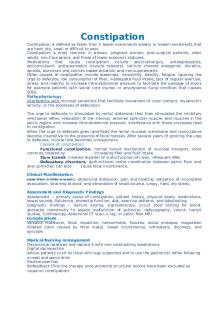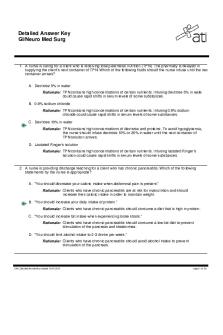GI Bleed Pre-Sim Questions PDF

| Title | GI Bleed Pre-Sim Questions |
|---|---|
| Course | Nursing Process - Adult Health |
| Institution | Samford University |
| Pages | 2 |
| File Size | 74 KB |
| File Type | |
| Total Downloads | 47 |
| Total Views | 138 |
Summary
GI bleed simulation questions...
Description
GI Bleed Pre-Sim Questions 1.What factors increase this patient’s risk for GI Bleed? There are several factors that increase this patient’s risk for a GI bleed, including the following: he’s a former smoker, older age, and excessive daily use of aspirin. His excessive aspirin use really puts him at risk for a major GI bleed because his blood is thinning out in combination with his age and former smoker status makes for a bad plethora of risk factors. GI bleeds can be very dangerous if not noticed and dealt with swiftly. 2. What are the differences between upper and lower GI bleed? A lower GI bleed occurs in the small intestine, large intestine, anus, or rectum and will present in the stool as bright red or melena due to where it is occurring. An upper GI bleed will occur in the esophagus, duodenum, or the stomach and will present in the stool as melena or in the vomit as bright red or coffee-like, which would be an alarming sign. A lower GI bleed will present as more of a hematochezia appearance due to its location. Upper and lower GI bleeds must both be taken seriously and dealt with swiftly. 3. How are these conditions diagnosed? There are various tests that can be used to diagnose GI disorders. First, for upper bleeds, an upper GI series uses a barium contrast to delineate the GI tract. In addition, these bleeds may be diagnosed with the use of a CT scan with contrast, an MRI, upper endoscopy, or even a colonoscopy. All of these tests have their own guidelines to follow, but for the most part they are all effective and helpful in diagnosing patient conditions. 4. What are the nursing implications associated with the administration of blood? There are several vital nursing implications associated with blood administration. First off, baseline vitals are crucial to know in order to have a comparison in case something does go wrong during the procedure. Also, the nurse should verify both the order and the patient’s blood type, verify the blood with another RN, and then hang the blood on its OWN line in a large gauge (18 G) IV. A blood transfusion must be started within 30 minutes of receiving the bag from the blood bank and has to be finished within a 4-hour time frame. The nurse must stay with the patient for the first 15 minutes to monitor for adverse reactions to the blood products. Also, blood should only be infused with normal saline and nothing else. The administration of blood products is a serious procedure that should never be downplayed or overlooked by the nurse. 5. What should the nurse consider when giving Morphine IV push? First of all, the nurse should always consider that morphine can cause respiratory depression, which is why it needs to be pushed slowly (a rapid push may cause chest wall rigidity and depression). Also, the nurse needs to be mindful of conditions present that contraindicate the use of morphine such as asthma for a patient, and they must always be mindful of the fact that morphine will cause sedation in most patients, which is why it is recommended that the patient stay sitting for a while after administration for response monitoring. 6. What are the nursing implications associated with the administration of IV Protonix? The primary concern with IV Protonix is that it may cause low magnesium levels. Magnesium supplementation may be required. Also, the nurse must closely monitor the patient for signs of diarrhea and severe abdominal cramping. For IV Protonix, the IV reconstituted form is stable for 6 hours at room temperature after reconstituting it; therefore, it doesn’t need to be left sitting out for long if it’s going to be used. Lastly, the patient should always avoid alcohol products while taking IV Protonix in order to ensure their safety and effectiveness of the drug.
7. If the patient continues to bleed, what further treatment options are available? If they continue to bleed after medication was administered, they may require a blood transfusion in order to keep up with their dwindling blood supply. The blood needs to be replaced; in addition, this patient would receive IV fluids in order to increase his blood volume, and they would definitely have to discontinue their daily aspirin use. All in all, blood and IV fluids would be necessary for a patient in this situation of prolonged bleeding without medication improvement. 8. What should the teaching plan for this patient include? There are multiple teaching points that I would recommend for this patient in this dire situation. First of all, they should discontinue their aspirin use (per the doctor’s order of course). Secondly, they should be redirected to a different pain controlling regimen that doesn’t carry the risk of being an antiplatelet that increases the risk for GI bleeding. This regimen could include the use of NSAIDs instead of aspirin to control his hand swelling. The patient should also be taught appropriate dosage for medications that he is taking and also to report signs and symptoms of bleeding that could be caught early and prevent major GI bleeding complications that might require blood transfusions and IV fluids....
Similar Free PDFs

GI Bleed Pre-Sim Questions
- 2 Pages

System Disorder- GI bleed
- 1 Pages

GI Bleed case study
- 10 Pages

GI Bleed Case Study
- 8 Pages

GI bleed ATI summary
- 9 Pages

Concept map GI bleed
- 3 Pages

ATI GI Bleed - ATI
- 4 Pages

Real Life - GI Bleed - Isbar
- 1 Pages

Lower GI Practice Questions
- 5 Pages

Nclex GI Questions-2
- 11 Pages

Med Surg GI practice questions
- 23 Pages

GI Adpie
- 5 Pages

Ati gi med surg - Gi study guide
- 53 Pages

Aircraft bleed air system
- 30 Pages

Only Woman Bleed Tab
- 2 Pages
Popular Institutions
- Tinajero National High School - Annex
- Politeknik Caltex Riau
- Yokohama City University
- SGT University
- University of Al-Qadisiyah
- Divine Word College of Vigan
- Techniek College Rotterdam
- Universidade de Santiago
- Universiti Teknologi MARA Cawangan Johor Kampus Pasir Gudang
- Poltekkes Kemenkes Yogyakarta
- Baguio City National High School
- Colegio san marcos
- preparatoria uno
- Centro de Bachillerato Tecnológico Industrial y de Servicios No. 107
- Dalian Maritime University
- Quang Trung Secondary School
- Colegio Tecnológico en Informática
- Corporación Regional de Educación Superior
- Grupo CEDVA
- Dar Al Uloom University
- Centro de Estudios Preuniversitarios de la Universidad Nacional de Ingeniería
- 上智大学
- Aakash International School, Nuna Majara
- San Felipe Neri Catholic School
- Kang Chiao International School - New Taipei City
- Misamis Occidental National High School
- Institución Educativa Escuela Normal Juan Ladrilleros
- Kolehiyo ng Pantukan
- Batanes State College
- Instituto Continental
- Sekolah Menengah Kejuruan Kesehatan Kaltara (Tarakan)
- Colegio de La Inmaculada Concepcion - Cebu
